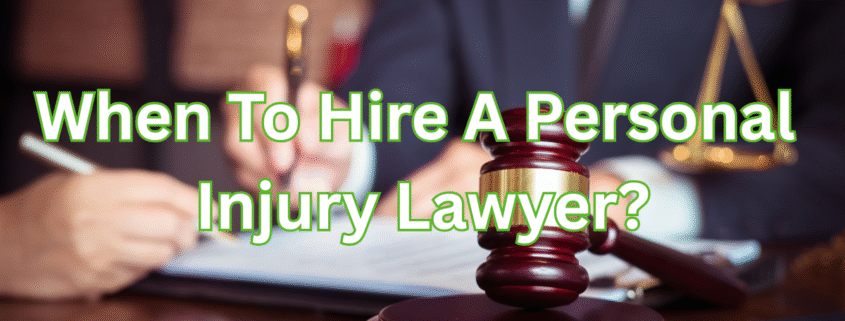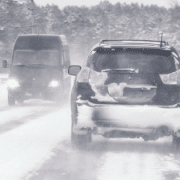When To Hire A Personal Injury Lawyer?
Hire a personal injury lawyer right after a serious crash, medical mistake, or fall when injuries are strong, blame is unclear, insurers stall, or Utah’s time limit nears. Fast legal help keeps proof safe and boosts the value of your claim.
One moment you are driving home, walking through a grocery aisle, or trusting your doctor’s steady hand. Next, you face pain, bills, and doubt about how to set things right. Utah injury laws give injured people the chance to recover lost pay, medical costs, and more. Yet the process is packed with rules, filing dates, and insurance tactics designed to shave dollars from every settlement.
Families often ask, “Do I need a lawyer or can I handle this on my own?”
This article is a road map written in plain language. We are going to make you aware of the types of cases personal injury lawyers accept. Also, we are going to let you know about the red flags that require professional help and how the state’s deadlines shape each step.
By understanding when to contact an attorney, how fees work, and why taking early action is beneficial for both your health and your wallet, you will see when to get the help you need.
Key Things You Should Remember
- Utah gives most victims four years to sue
- Wrongful death claims end after two years
- Medical errors need a notice letter within 90 days
- Photos, skid marks, and camera footage fade fast
- Insurance software often undervalues pain and lost work
- Health plans can demand payback from your settlement
- Witness memories fade within weeks
- Truck wreck data may vanish if not preserved quickly
- Kids’ settlements need court approval
- City or state claims require notice in one year
- Lawyers usually work on contingency, no win–no fee
- Early advice prevents costly filing mistakes
What Cases Do Personal Injury Lawyers Handle?
An accident attorney in Utah tackles much more than car wrecks. Any event where careless or reckless behavior harms another person can lead to a claim. Each case type below carries different proof needs, time limits, and insurance rules. Knowing where your situation fits helps you see why skilled help matters.
| Case Type | Short Description |
| Car crashes | Collects police reports, repair records, and witness notes to prove fault. |
| Truck accidents | Uses federal logbooks and black-box data to show safety breaches. |
| Motorcycle wrecks | Counters bias that riders “assumed the risk” with clear crash reconstruction. |
| Slip and fall | Gather maintenance logs, safety invoices, and store videos to prove hazard awareness. |
| Medical mistakes | Requires sworn expert support before filing in court. |
| Defective products | Teams with engineers to reveal design or manufacturing flaws. |
| Wrongful death | Calculates future lost earnings and care for dependents. |
| Dog bites | Applies Utah’s strict liability rules to establish owner duty. |
| Construction injuries | Reviews OSHA reports and contractor agreements to show negligence. |
| Catastrophic harm | Plans lifelong care costs through medical economists and life planners. |
Each category brings its own maze of statutes and technical proof. An injury compensation lawyer keeps every piece in order while you focus on healing.
Scenarios When Hiring a Personal Injury Lawyer Is Necessary
Not every scrape needs legal firepower. A bruised knee that heals in a week may settle quickly. But some events need seasoned guidance the moment they happen. Below are ten real-world situations that leave everyday people at risk of losing thousands of dollars or their entire case without skilled representation.
Severe Injuries With High Medical Bills
An injury such as a broken vertebra, a torn ligament, or an internal injury can lead to months away from work, surgery, and rehabilitation. A hospital lien attaches to your file, and your health insurer seeks reimbursement for every expense it covers. A civil litigation lawyer does more than file forms.
They gather every record, forecast future therapy, and bring in doctors who explain long-term impacts in clear terms. Utah juries often reward honest, detailed proof of pain and lost function. Without it, insurers lump you into a low payout bracket.
A strong damages package includes mileage to therapy, out-of-pocket medical gear, and even home help for chores you can no longer manage. By building this full picture early, counsel stops the common tactic of insurers disputing each cost line by line. Together, these steps turn a rough estimate into a settlement that truly matches lifelong needs.
Liability Is Disputed or Shared
Utah follows a modified comparative fault. If you are 50% or more at fault, you recover zero. Even a smaller share cuts your award.
Evidence must show who was speeding, who braked too late, and whether road crews salted the lane. A trial advocacy lawyer hires accident reconstruction experts to analyze skid marks, road grade, streetlights, and event-data recorders.
Phone records may reveal a driver texting. Surveillance video from nearby businesses can pinpoint impact angles. While you focus on physical therapy, your lawyer lines up proof that drops your fault share, preserves your right to damages, and pushes responsible parties to pay their portion.
The Insurer Denies or Lowballs Your Claim
Claims departments train adjusters to protect profit. Software programs churn out “fair” numbers based on average payouts, not your personal pain. If you receive an offer that barely clears hospital charges, legal pressure changes the game.
An accident attorney sends a detailed demand letter with a clear dollar figure backed by medical notes, billing codes, and expert forecasts. They remind the insurer of bad-faith penalties if it stonewalls.
Once a lawsuit is filed, discovery rules force the carrier to release internal claim notes, previous settlement ranges, and the adjuster’s performance metrics. Many times, the possibility of those details reaching a jury table tips negotiations in your favor.
Permanent Disability or Catastrophic Harm
A catastrophic injury attorney builds a life-care plan. This report prices wheelchairs, home ramps, future revision surgeries, vocational retraining, and even mental health care for post-traumatic stress.
Economists then adjust those figures to today’s dollars and future inflation. Without such a plan, settlement talks stall around current hospital bills alone. Counsel also files for Social Security Disability or workers’ compensation offsets when allowed, weaving all benefits into one coordinated strategy so you do not leave money on the table.
Wrongful Death of a Loved One
Grief can freeze action, yet Utah grants only two years for wrongful death suits. Spouses and children may rely on the deceased’s paycheck, health insurance, and guidance. A wrongful death attorney works with probate courts to appoint a personal representative, gathers wage records, and calculates lost future promotions and retirement contributions.
They interview co-workers to prove the decedent’s role in supporting the family. By translating deep personal loss into numbers, the court can understand, and the counsel secures funds for housing, schooling, and day-to-day living that the deceased would have provided.
Medical Malpractice With Strict Notice Rules
If a surgeon clips a nerve or a nurse gives the wrong dose, you have two years from discovery to act and must file a notice of intent 90 days before suing. A medical malpractice lawyer reviews charts with specialist physicians, looking for deviations from accepted standards. They also prepare an affidavit that survives Utah’s prelitigation screening panel.
Crashes Involving Commercial Trucks or Buses
Big-rigs carry higher insurance limits but complex liability webs. A tort law attorney sends preservation letters within days to stop companies from shredding driver logs, maintenance records, and on-board camera footage. Federal rules cap driver hours and set weight limits. Violations often prove negligence. The lawyer may also sue the shipper for overloading freight or the service shop for faulty brakes. Robust discovery pushes more parties to contribute to a global settlement that meets the true scale of harm.
Injury on Government Property
Slip on an unshoveled courthouse step or collide with a city garbage truck, and you face the Governmental Immunity Act. Victims must file a written notice within one year, and sometimes shorter if federal claims arise.
Damage caps may apply, yet they still allow recovery for medical bills and lost income. A bodily injury attorney assists in drafting the notice, citing correct statutes, and routing copies to every required office. One wrong address can void your claim. Counsel’s local know-how ensures each box is checked on time.
Deadline Is Nearing and Evidence Is Fading
Physical proof (skid marks, torn carpet, or broken handrails) can disappear within weeks. Witnesses move, and camera systems overwrite old footage. If you wait until month 47 of Utah’s four-year limit, even the best lawyer may struggle.
A contingency fee personal injury lawyer opens your file the day you hire them. They gather 911 tapes, send subpoenas for traffic video, photograph bruises before they heal, and store damaged products in safe facilities. Early groundwork keeps your story alive long after the scene is cleaned up.
These ten scenarios share one theme: complexity. Paperwork, medical codes, expert opinions, and strict filing clocks leave little room for error. A trained legal team keeps each piece in place, speaks insurance language, and balances pressure with patience to reach a fair resolution.
Call a Local Personal Injury Attorney in Utah Today
Minutes count after a crash or medical error. The sooner you call, the sooner vital proof is locked in. Cockayne Law has helped Utah families from Salt Lake City to St. George stand up to national insurers and big corporations. Their team is available 24 hours a day and 7 days a week, offering free consultations and working on a no-win, no-fee basis.
Upon arrival on the scene, investigators photograph hazards and interview witnesses. Surgeons are then assigned to explain your condition. While you focus on therapy and family, they track every bill and deadline.
Call or email today before evidence slips away or a filing window closes. One friendly chat can set a plan in motion and give you peace of mind.
Final Thoughts
Utah’s injury laws aim to make injured people whole, yet the maze of forms, time limits, and insurance strategies often tilts the field. A good lawyer brings balance. They protect proof, value your losses fairly, and push insurers to honor their promises. You get space to heal, work on recovery, and care for loved ones. If any of the warning signs in this guide sound familiar—serious harm, unclear blame, or stalled adjusters – reach out today. Early legal help turns a confusing process into a clear path forward.
FAQs
When should you contact an injury attorney?
Right after medical care. Early advice secures evidence, stops adjuster tricks, and sets your claim on the right track.
What are three common situations when you should consider seeing a lawyer?
Major injuries, disagreement over fault, and any time an insurer denies or slashes your claim amount.
What percentage do most personal injury lawyers take?
Personal injury lawyers take about 33% of the final recovery, though some firms use a sliding scale based on how far the case goes.
Does Utah have a time limit for filing injury cases?
Yes. Most actions must start within four years. Wrongful death actions end at two years, with even shorter limits for suits against government entities.

















